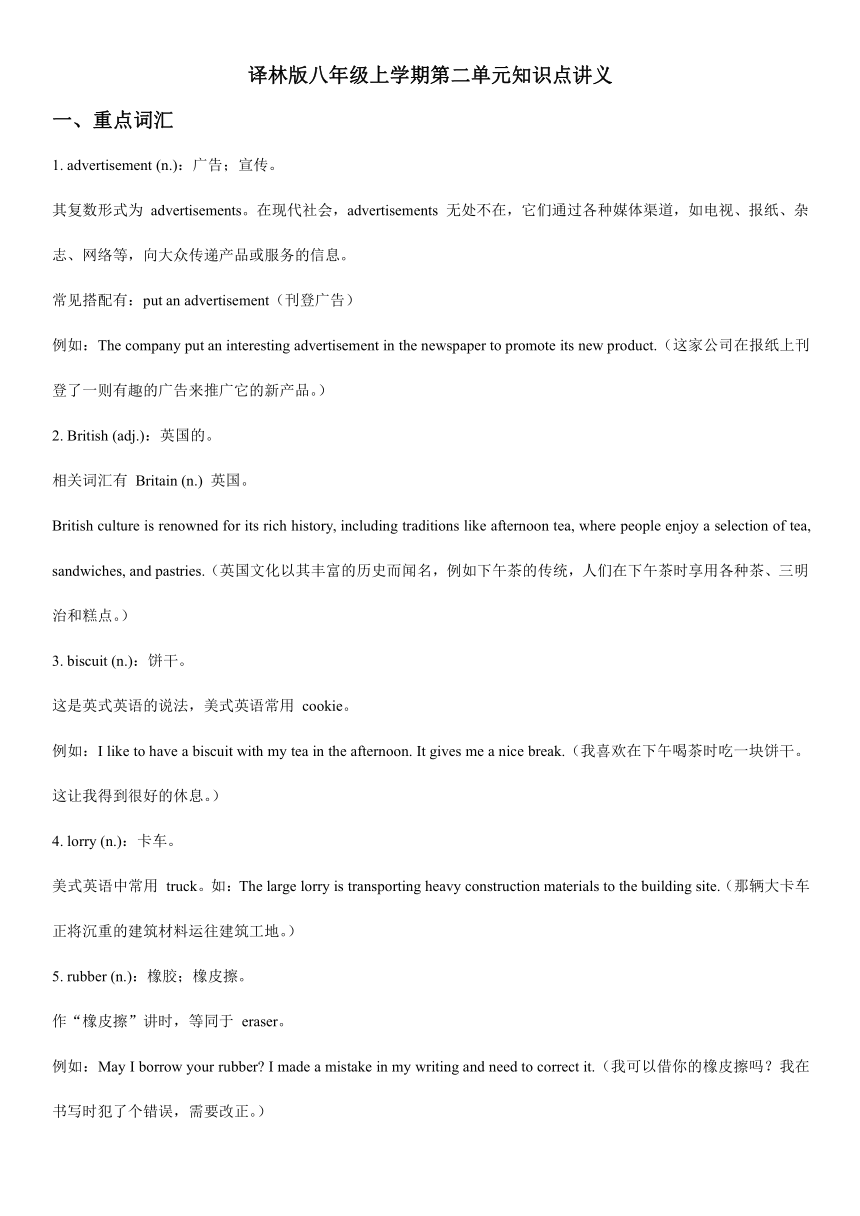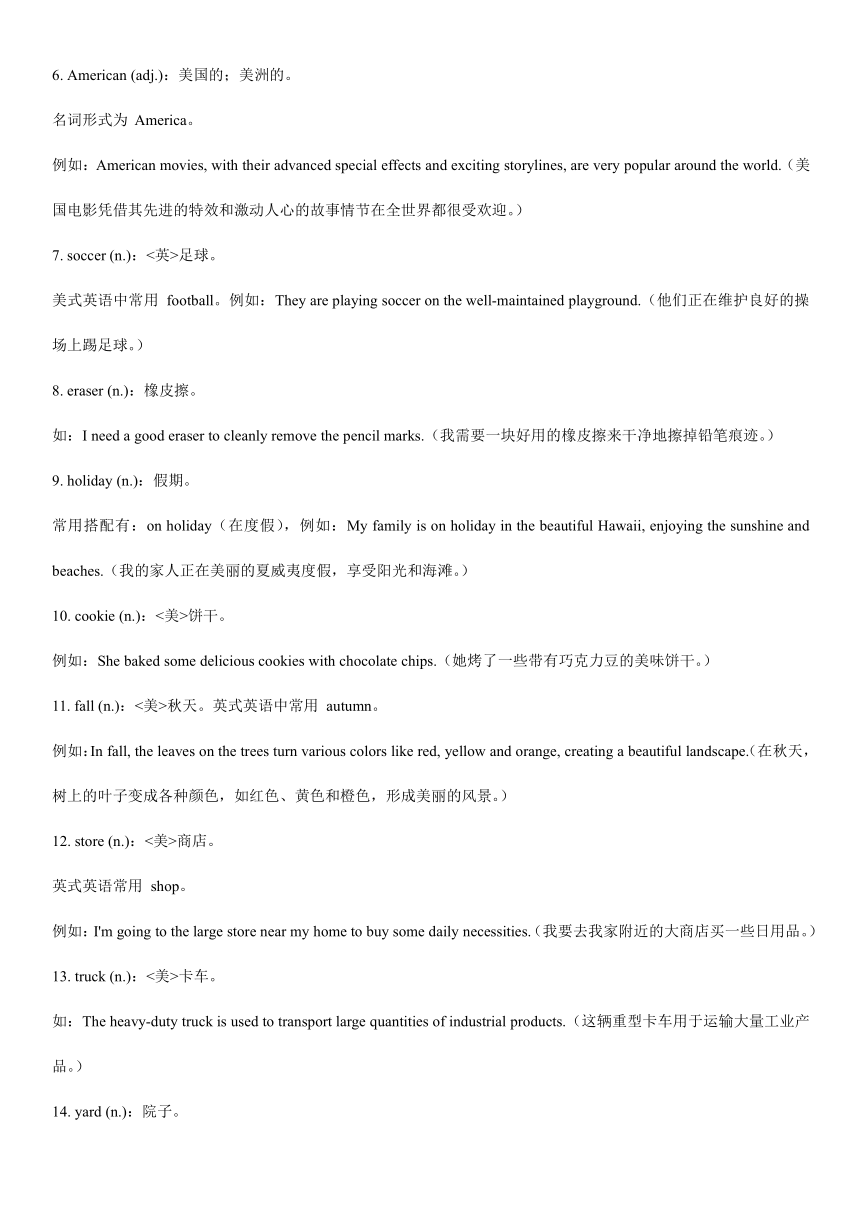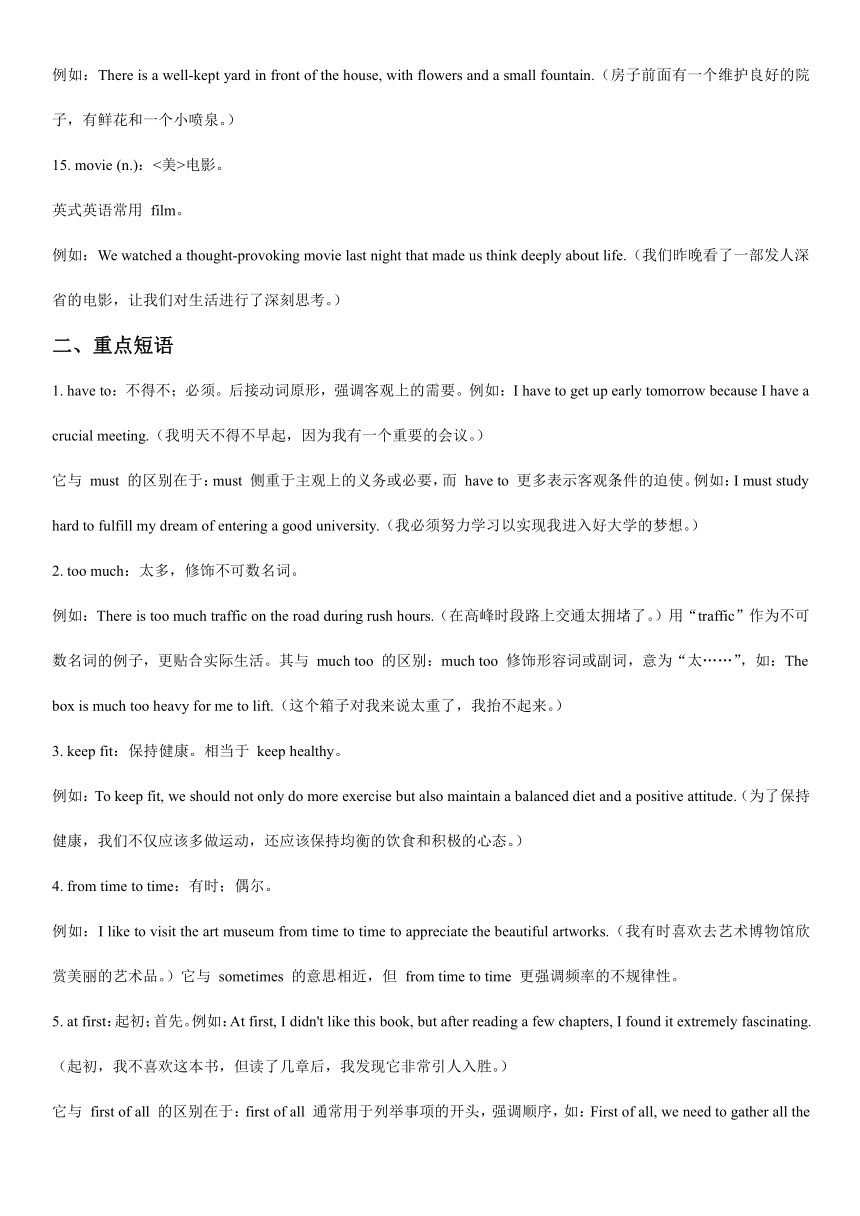牛津译林版八年级上册 Unit 2 School life 知识点讲义
文档属性
| 名称 | 牛津译林版八年级上册 Unit 2 School life 知识点讲义 |  | |
| 格式 | docx | ||
| 文件大小 | 26.0KB | ||
| 资源类型 | 教案 | ||
| 版本资源 | 牛津译林版 | ||
| 科目 | 英语 | ||
| 更新时间 | 2024-11-23 22:02:54 | ||
图片预览



文档简介
译林版八年级上学期第二单元知识点讲义
一、重点词汇
1. advertisement (n.):广告;宣传。
其复数形式为 advertisements。在现代社会,advertisements 无处不在,它们通过各种媒体渠道,如电视、报纸、杂志、网络等,向大众传递产品或服务的信息。
常见搭配有:put an advertisement(刊登广告)
例如:The company put an interesting advertisement in the newspaper to promote its new product.(这家公司在报纸上刊登了一则有趣的广告来推广它的新产品。)
2. British (adj.):英国的。
相关词汇有 Britain (n.) 英国。
British culture is renowned for its rich history, including traditions like afternoon tea, where people enjoy a selection of tea, sandwiches, and pastries.(英国文化以其丰富的历史而闻名,例如下午茶的传统,人们在下午茶时享用各种茶、三明治和糕点。)
3. biscuit (n.):饼干。
这是英式英语的说法,美式英语常用 cookie。
例如:I like to have a biscuit with my tea in the afternoon. It gives me a nice break.(我喜欢在下午喝茶时吃一块饼干。这让我得到很好的休息。)
4. lorry (n.):卡车。
美式英语中常用 truck。如:The large lorry is transporting heavy construction materials to the building site.(那辆大卡车正将沉重的建筑材料运往建筑工地。)
5. rubber (n.):橡胶;橡皮擦。
作“橡皮擦”讲时,等同于 eraser。
例如:May I borrow your rubber I made a mistake in my writing and need to correct it.(我可以借你的橡皮擦吗?我在书写时犯了个错误,需要改正。)
6. American (adj.):美国的;美洲的。
名词形式为 America。
例如:American movies, with their advanced special effects and exciting storylines, are very popular around the world.(美国电影凭借其先进的特效和激动人心的故事情节在全世界都很受欢迎。)
7. soccer (n.):<英>足球。
美式英语中常用 football。例如:They are playing soccer on the well-maintained playground.(他们正在维护良好的操场上踢足球。)
8. eraser (n.):橡皮擦。
如:I need a good eraser to cleanly remove the pencil marks.(我需要一块好用的橡皮擦来干净地擦掉铅笔痕迹。)
9. holiday (n.):假期。
常用搭配有:on holiday(在度假),例如:My family is on holiday in the beautiful Hawaii, enjoying the sunshine and beaches.(我的家人正在美丽的夏威夷度假,享受阳光和海滩。)
10. cookie (n.):<美>饼干。
例如:She baked some delicious cookies with chocolate chips.(她烤了一些带有巧克力豆的美味饼干。)
11. fall (n.):<美>秋天。英式英语中常用 autumn。
例如:In fall, the leaves on the trees turn various colors like red, yellow and orange, creating a beautiful landscape.(在秋天,树上的叶子变成各种颜色,如红色、黄色和橙色,形成美丽的风景。)
12. store (n.):<美>商店。
英式英语常用 shop。
例如:I'm going to the large store near my home to buy some daily necessities.(我要去我家附近的大商店买一些日用品。)
13. truck (n.):<美>卡车。
如:The heavy-duty truck is used to transport large quantities of industrial products.(这辆重型卡车用于运输大量工业产品。)
14. yard (n.):院子。
例如:There is a well-kept yard in front of the house, with flowers and a small fountain.(房子前面有一个维护良好的院子,有鲜花和一个小喷泉。)
15. movie (n.):<美>电影。
英式英语常用 film。
例如:We watched a thought-provoking movie last night that made us think deeply about life.(我们昨晚看了一部发人深省的电影,让我们对生活进行了深刻思考。)
二、重点短语
1. have to:不得不;必须。后接动词原形,强调客观上的需要。例如:I have to get up early tomorrow because I have a crucial meeting.(我明天不得不早起,因为我有一个重要的会议。)
它与 must 的区别在于:must 侧重于主观上的义务或必要,而 have to 更多表示客观条件的迫使。例如:I must study hard to fulfill my dream of entering a good university.(我必须努力学习以实现我进入好大学的梦想。)
2. too much:太多,修饰不可数名词。
例如:There is too much traffic on the road during rush hours.(在高峰时段路上交通太拥堵了。)用“traffic”作为不可数名词的例子,更贴合实际生活。其与 much too 的区别:much too 修饰形容词或副词,意为“太……”,如:The box is much too heavy for me to lift.(这个箱子对我来说太重了,我抬不起来。)
3. keep fit:保持健康。相当于 keep healthy。
例如:To keep fit, we should not only do more exercise but also maintain a balanced diet and a positive attitude.(为了保持健康,我们不仅应该多做运动,还应该保持均衡的饮食和积极的心态。)
4. from time to time:有时;偶尔。
例如:I like to visit the art museum from time to time to appreciate the beautiful artworks.(我有时喜欢去艺术博物馆欣赏美丽的艺术品。)它与 sometimes 的意思相近,但 from time to time 更强调频率的不规律性。
5. at first:起初;首先。例如:At first, I didn't like this book, but after reading a few chapters, I found it extremely fascinating.(起初,我不喜欢这本书,但读了几章后,我发现它非常引人入胜。)
它与 first of all 的区别在于:first of all 通常用于列举事项的开头,强调顺序,如:First of all, we need to gather all the materials. Then we can start the project.(首先,我们需要收集所有的材料。然后我们才能开始这个项目。)
6. feel bored:感到无聊。
例如:When I have to wait for a long time without anything to do, I feel extremely bored.(当我不得不长时间等待且无事可做时,我感到极其无聊。)强调无聊程度,让学生体会词汇在语境中的情感表达。bored 用来形容人的感受,而 boring 用来形容事物“令人无聊的”,如:The long and tedious lecture is boring.(这个冗长乏味的讲座很无聊。)
7. such as:例如,用来列举事物。
例如:I like fruits such as apples, which are rich in vitamins, bananas that provide potassium, and oranges full of vitamin C.(我喜欢水果,例如富含维生素的苹果、提供钾元素的香蕉以及充满维生素 C 的橙子。)
它与 for example 的区别在于:for example 一般只列举一个例子,且通常用逗号隔开,如:I have many hobbies. For example, I like painting. It allows me to express my creativity.(我有很多爱好。例如,我喜欢绘画。它让我能够表达我的创造力。)
8. spend... on sth. / (in) doing sth.:在某事上花费…… / 花费……做某事。
例如:I spent 300 yuan on this high-quality smartphone.(我在这部高质量的智能手机上花了 300 元。)I spent two hours (in) preparing for the important exam.(我花了两个小时准备这次重要的考试。)
注意:take 也有“花费”的意思,但用法不同,如:It takes me 45 minutes to commute to work by subway.(我乘坐地铁上班需要花费 45 分钟。)这里 it 作形式主语,真正的主语是后面的动词不定式。通过不同场景下的例句,对比 spend 和 take 的用法。
9. be different from:与……不同。
例如:Chinese painting is different from Western painting in terms of brushwork, color use and composition.(中国画在笔法、色彩运用和构图方面与西方绘画不同。)从艺术领域阐述两者差异,拓宽学生知识面。其反义词组为 be the same as(与……相同),如:My answer to this math problem is the same as yours.(我对这道数学题的答案和你的相同。)
10. a group of:一群;一组。例如:A group of enthusiastic volunteers are helping to clean up the park.(一群热情的志愿者正在帮忙清理公园。)
11. mix... with...:把……和……混合。
例如:You should mix the eggs with the flour carefully to make a smooth batter.(你应该小心地把鸡蛋和面粉混合,制成光滑的面糊。)
12. add... to...:把……加到……上。
例如:Add a spoonful of sugar to the coffee to make it taste sweeter.(往咖啡里加一勺糖,让它尝起来更甜。)
13. be ready to do sth.:准备好做某事;乐意做某事。例如:I'm ready to face any challenges in the upcoming competition.(我准备好面对即将到来的比赛中的任何挑战。)
它与 get ready to do sth. 的区别在于:get ready to do sth. 强调准备的动作过程,而 be ready to do sth. 强调准备好的状态。例如:I'm getting ready to give a speech by practicing my pronunciation and rehearsing the content.(我正在通过练习发音和排练内容为演讲做准备。)
14. all over the world:全世界。
例如:The Internet has enabled people all over the world to communicate and share information instantly.(互联网使全世界的人们能够即时交流和分享信息。)
15. as well:也,用于肯定句末,相当于 too。
例如:I enjoy reading novels and I like watching movies as well.(我喜欢读小说,我也喜欢看电影。)
三、重点句型
1. What about doing sth. :做某事怎么样?这是一个用来提出建议或征求意见的句型。
例如:What about going to the newly opened art exhibition this weekend (这个周末去新开的艺术展览怎么样?)其同义句型还有:How about doing sth. 例如:How about trying the new Italian restaurant in town (去尝尝镇上那家新的意大利餐厅怎么样?)
2. It takes sb. some time to do sth.:某人花费多长时间做某事。
如:It takes me an hour and a half to finish my homework every day.(我每天花费一个半小时完成作业。)在这个句型中,it 是形式主语,真正的主语是后面的动词不定式短语 to do sth.。可以进一步举例说明不同时间的花费,如:It takes him 20 minutes to walk to school.(他步行去学校需要花费 20 分钟。)
3. Sb. spend some time / money on sth. / (in) doing sth.:某人在某事上花费时间 / 金钱或花费时间 / 金钱做某事。
例如:She spent 500 dollars on the designer dress.(她在那件名牌裙子上花了 500 美元。)He spent three hours (in) building a model airplane.(他花了三个小时制作一架模型飞机。)
4. Why not do sth. :为什么不做某事呢?这是一个表示建议的句型,相当于 Why don't you do sth.
例如:Why not join the school choir It's a great way to improve your singing skills.(为什么不加入学校合唱团呢?这是提高你歌唱技巧的好方法。)
5. try to do sth. / try doing sth.:try to do sth. 努力做某事;try doing sth. 尝试做某事。
例如:I'll try to solve the difficult math problem by using different methods.(我会努力通过不同方法解决这道数学难题。)You can try adding some spices to the dish. It may enhance the flavor.(你可以尝试往菜里加一些香料。这可能会提升味道。)
6. The number of... is...:……的数量是……。
这里的主语是 the number,谓语动词用单数形式。例如:The number of students who participate in the science competition is increasing.(参加科学竞赛的学生数量在增加。)
其与 a number of... 的区别在于:a number of... 意为“许多……”,修饰可数名词复数,作主语时,谓语动词用复数形式。例如:A number of young people are interested in learning new technologies.(许多年轻人对学习新技术感兴趣。)
7. between... and...:在……和……之间(两者之间)。
例如:The library is located between the school and the community center.(图书馆位于学校和社区中心之间。)
而 among 表示“在……之中(三者或三者以上)”,如:The teacher is standing among the group of students, answering their questions.(老师正站在一群学生中间,回答他们的问题。)
8. It seems that...:似乎……;好像……。
例如:It seems that he has made great progress in his English studies.(他似乎在英语学习上取得了很大进步。)
其同义句型为:Sb. / Sth. seems to be... / to do sth. 例如:He seems to be very confident in his abilities.(他似乎对自己的能力很有信心。)The project seems to be going smoothly.(这个项目似乎进展顺利。)
四、语法知识点
动词不定式
1. 动词不定式的基本形式是“to + 动词原形”,它在句中不能作谓语,但可以作主语、宾语、宾语补足语、定语、状语等。
- 作主语:To master a foreign language well requires a lot of practice and dedication.(学好一门外语需要大量的练习和专注。)为了避免句子头重脚轻,常用 it 作形式主语,而将真正的主语动词不定式后置,即:It is necessary to master a foreign language well. 可以进一步举例说明不同学科或技能学习中动词不定式作主语的情况,如:To play a musical instrument proficiently takes years of training.(熟练演奏一种乐器需要多年的训练。)
- 作宾语:
- 一些动词后面常接动词不定式作宾语,如:want(想要),decide(决定),hope(希望),plan(计划),expect(期待)等。例如:I want to travel around the world to experience different cultures.(我想要环游世界去体验不同文化。)
- 疑问词 + 动词不定式结构也可以作宾语,例如:I don't know which book to choose for my reading assignment.(我不知道为我的阅读作业选哪本书。)可以多举几个疑问词引导的例子,如:I wonder how to solve this complex problem.(我想知道如何解决这个复杂问题。)
- 作宾语补足语:
- 一些动词后面接动词不定式作宾语补足语,如:ask(要求),tell(告诉),want(想要),help(帮助)等。例如:The teacher asked us to write an essay about our summer vacation.(老师要求我们写一篇关于暑假的文章。)需要注意的是,help 后面的动词不定式可带 to 也可不带 to,如:He often helps me (to) understand difficult math concepts. 可以列举更多学科知识方面的例子,如:The coach helps the players (to) improve their skills.(教练帮助运动员提高他们的技能。)
- 作定语:动词不定式作定语时,要放在被修饰词之后,通常表示将要发生的动作。例如:I have a lot of homework to finish before tomorrow.(我有很多作业要在明天之前写完)
一、重点词汇
1. advertisement (n.):广告;宣传。
其复数形式为 advertisements。在现代社会,advertisements 无处不在,它们通过各种媒体渠道,如电视、报纸、杂志、网络等,向大众传递产品或服务的信息。
常见搭配有:put an advertisement(刊登广告)
例如:The company put an interesting advertisement in the newspaper to promote its new product.(这家公司在报纸上刊登了一则有趣的广告来推广它的新产品。)
2. British (adj.):英国的。
相关词汇有 Britain (n.) 英国。
British culture is renowned for its rich history, including traditions like afternoon tea, where people enjoy a selection of tea, sandwiches, and pastries.(英国文化以其丰富的历史而闻名,例如下午茶的传统,人们在下午茶时享用各种茶、三明治和糕点。)
3. biscuit (n.):饼干。
这是英式英语的说法,美式英语常用 cookie。
例如:I like to have a biscuit with my tea in the afternoon. It gives me a nice break.(我喜欢在下午喝茶时吃一块饼干。这让我得到很好的休息。)
4. lorry (n.):卡车。
美式英语中常用 truck。如:The large lorry is transporting heavy construction materials to the building site.(那辆大卡车正将沉重的建筑材料运往建筑工地。)
5. rubber (n.):橡胶;橡皮擦。
作“橡皮擦”讲时,等同于 eraser。
例如:May I borrow your rubber I made a mistake in my writing and need to correct it.(我可以借你的橡皮擦吗?我在书写时犯了个错误,需要改正。)
6. American (adj.):美国的;美洲的。
名词形式为 America。
例如:American movies, with their advanced special effects and exciting storylines, are very popular around the world.(美国电影凭借其先进的特效和激动人心的故事情节在全世界都很受欢迎。)
7. soccer (n.):<英>足球。
美式英语中常用 football。例如:They are playing soccer on the well-maintained playground.(他们正在维护良好的操场上踢足球。)
8. eraser (n.):橡皮擦。
如:I need a good eraser to cleanly remove the pencil marks.(我需要一块好用的橡皮擦来干净地擦掉铅笔痕迹。)
9. holiday (n.):假期。
常用搭配有:on holiday(在度假),例如:My family is on holiday in the beautiful Hawaii, enjoying the sunshine and beaches.(我的家人正在美丽的夏威夷度假,享受阳光和海滩。)
10. cookie (n.):<美>饼干。
例如:She baked some delicious cookies with chocolate chips.(她烤了一些带有巧克力豆的美味饼干。)
11. fall (n.):<美>秋天。英式英语中常用 autumn。
例如:In fall, the leaves on the trees turn various colors like red, yellow and orange, creating a beautiful landscape.(在秋天,树上的叶子变成各种颜色,如红色、黄色和橙色,形成美丽的风景。)
12. store (n.):<美>商店。
英式英语常用 shop。
例如:I'm going to the large store near my home to buy some daily necessities.(我要去我家附近的大商店买一些日用品。)
13. truck (n.):<美>卡车。
如:The heavy-duty truck is used to transport large quantities of industrial products.(这辆重型卡车用于运输大量工业产品。)
14. yard (n.):院子。
例如:There is a well-kept yard in front of the house, with flowers and a small fountain.(房子前面有一个维护良好的院子,有鲜花和一个小喷泉。)
15. movie (n.):<美>电影。
英式英语常用 film。
例如:We watched a thought-provoking movie last night that made us think deeply about life.(我们昨晚看了一部发人深省的电影,让我们对生活进行了深刻思考。)
二、重点短语
1. have to:不得不;必须。后接动词原形,强调客观上的需要。例如:I have to get up early tomorrow because I have a crucial meeting.(我明天不得不早起,因为我有一个重要的会议。)
它与 must 的区别在于:must 侧重于主观上的义务或必要,而 have to 更多表示客观条件的迫使。例如:I must study hard to fulfill my dream of entering a good university.(我必须努力学习以实现我进入好大学的梦想。)
2. too much:太多,修饰不可数名词。
例如:There is too much traffic on the road during rush hours.(在高峰时段路上交通太拥堵了。)用“traffic”作为不可数名词的例子,更贴合实际生活。其与 much too 的区别:much too 修饰形容词或副词,意为“太……”,如:The box is much too heavy for me to lift.(这个箱子对我来说太重了,我抬不起来。)
3. keep fit:保持健康。相当于 keep healthy。
例如:To keep fit, we should not only do more exercise but also maintain a balanced diet and a positive attitude.(为了保持健康,我们不仅应该多做运动,还应该保持均衡的饮食和积极的心态。)
4. from time to time:有时;偶尔。
例如:I like to visit the art museum from time to time to appreciate the beautiful artworks.(我有时喜欢去艺术博物馆欣赏美丽的艺术品。)它与 sometimes 的意思相近,但 from time to time 更强调频率的不规律性。
5. at first:起初;首先。例如:At first, I didn't like this book, but after reading a few chapters, I found it extremely fascinating.(起初,我不喜欢这本书,但读了几章后,我发现它非常引人入胜。)
它与 first of all 的区别在于:first of all 通常用于列举事项的开头,强调顺序,如:First of all, we need to gather all the materials. Then we can start the project.(首先,我们需要收集所有的材料。然后我们才能开始这个项目。)
6. feel bored:感到无聊。
例如:When I have to wait for a long time without anything to do, I feel extremely bored.(当我不得不长时间等待且无事可做时,我感到极其无聊。)强调无聊程度,让学生体会词汇在语境中的情感表达。bored 用来形容人的感受,而 boring 用来形容事物“令人无聊的”,如:The long and tedious lecture is boring.(这个冗长乏味的讲座很无聊。)
7. such as:例如,用来列举事物。
例如:I like fruits such as apples, which are rich in vitamins, bananas that provide potassium, and oranges full of vitamin C.(我喜欢水果,例如富含维生素的苹果、提供钾元素的香蕉以及充满维生素 C 的橙子。)
它与 for example 的区别在于:for example 一般只列举一个例子,且通常用逗号隔开,如:I have many hobbies. For example, I like painting. It allows me to express my creativity.(我有很多爱好。例如,我喜欢绘画。它让我能够表达我的创造力。)
8. spend... on sth. / (in) doing sth.:在某事上花费…… / 花费……做某事。
例如:I spent 300 yuan on this high-quality smartphone.(我在这部高质量的智能手机上花了 300 元。)I spent two hours (in) preparing for the important exam.(我花了两个小时准备这次重要的考试。)
注意:take 也有“花费”的意思,但用法不同,如:It takes me 45 minutes to commute to work by subway.(我乘坐地铁上班需要花费 45 分钟。)这里 it 作形式主语,真正的主语是后面的动词不定式。通过不同场景下的例句,对比 spend 和 take 的用法。
9. be different from:与……不同。
例如:Chinese painting is different from Western painting in terms of brushwork, color use and composition.(中国画在笔法、色彩运用和构图方面与西方绘画不同。)从艺术领域阐述两者差异,拓宽学生知识面。其反义词组为 be the same as(与……相同),如:My answer to this math problem is the same as yours.(我对这道数学题的答案和你的相同。)
10. a group of:一群;一组。例如:A group of enthusiastic volunteers are helping to clean up the park.(一群热情的志愿者正在帮忙清理公园。)
11. mix... with...:把……和……混合。
例如:You should mix the eggs with the flour carefully to make a smooth batter.(你应该小心地把鸡蛋和面粉混合,制成光滑的面糊。)
12. add... to...:把……加到……上。
例如:Add a spoonful of sugar to the coffee to make it taste sweeter.(往咖啡里加一勺糖,让它尝起来更甜。)
13. be ready to do sth.:准备好做某事;乐意做某事。例如:I'm ready to face any challenges in the upcoming competition.(我准备好面对即将到来的比赛中的任何挑战。)
它与 get ready to do sth. 的区别在于:get ready to do sth. 强调准备的动作过程,而 be ready to do sth. 强调准备好的状态。例如:I'm getting ready to give a speech by practicing my pronunciation and rehearsing the content.(我正在通过练习发音和排练内容为演讲做准备。)
14. all over the world:全世界。
例如:The Internet has enabled people all over the world to communicate and share information instantly.(互联网使全世界的人们能够即时交流和分享信息。)
15. as well:也,用于肯定句末,相当于 too。
例如:I enjoy reading novels and I like watching movies as well.(我喜欢读小说,我也喜欢看电影。)
三、重点句型
1. What about doing sth. :做某事怎么样?这是一个用来提出建议或征求意见的句型。
例如:What about going to the newly opened art exhibition this weekend (这个周末去新开的艺术展览怎么样?)其同义句型还有:How about doing sth. 例如:How about trying the new Italian restaurant in town (去尝尝镇上那家新的意大利餐厅怎么样?)
2. It takes sb. some time to do sth.:某人花费多长时间做某事。
如:It takes me an hour and a half to finish my homework every day.(我每天花费一个半小时完成作业。)在这个句型中,it 是形式主语,真正的主语是后面的动词不定式短语 to do sth.。可以进一步举例说明不同时间的花费,如:It takes him 20 minutes to walk to school.(他步行去学校需要花费 20 分钟。)
3. Sb. spend some time / money on sth. / (in) doing sth.:某人在某事上花费时间 / 金钱或花费时间 / 金钱做某事。
例如:She spent 500 dollars on the designer dress.(她在那件名牌裙子上花了 500 美元。)He spent three hours (in) building a model airplane.(他花了三个小时制作一架模型飞机。)
4. Why not do sth. :为什么不做某事呢?这是一个表示建议的句型,相当于 Why don't you do sth.
例如:Why not join the school choir It's a great way to improve your singing skills.(为什么不加入学校合唱团呢?这是提高你歌唱技巧的好方法。)
5. try to do sth. / try doing sth.:try to do sth. 努力做某事;try doing sth. 尝试做某事。
例如:I'll try to solve the difficult math problem by using different methods.(我会努力通过不同方法解决这道数学难题。)You can try adding some spices to the dish. It may enhance the flavor.(你可以尝试往菜里加一些香料。这可能会提升味道。)
6. The number of... is...:……的数量是……。
这里的主语是 the number,谓语动词用单数形式。例如:The number of students who participate in the science competition is increasing.(参加科学竞赛的学生数量在增加。)
其与 a number of... 的区别在于:a number of... 意为“许多……”,修饰可数名词复数,作主语时,谓语动词用复数形式。例如:A number of young people are interested in learning new technologies.(许多年轻人对学习新技术感兴趣。)
7. between... and...:在……和……之间(两者之间)。
例如:The library is located between the school and the community center.(图书馆位于学校和社区中心之间。)
而 among 表示“在……之中(三者或三者以上)”,如:The teacher is standing among the group of students, answering their questions.(老师正站在一群学生中间,回答他们的问题。)
8. It seems that...:似乎……;好像……。
例如:It seems that he has made great progress in his English studies.(他似乎在英语学习上取得了很大进步。)
其同义句型为:Sb. / Sth. seems to be... / to do sth. 例如:He seems to be very confident in his abilities.(他似乎对自己的能力很有信心。)The project seems to be going smoothly.(这个项目似乎进展顺利。)
四、语法知识点
动词不定式
1. 动词不定式的基本形式是“to + 动词原形”,它在句中不能作谓语,但可以作主语、宾语、宾语补足语、定语、状语等。
- 作主语:To master a foreign language well requires a lot of practice and dedication.(学好一门外语需要大量的练习和专注。)为了避免句子头重脚轻,常用 it 作形式主语,而将真正的主语动词不定式后置,即:It is necessary to master a foreign language well. 可以进一步举例说明不同学科或技能学习中动词不定式作主语的情况,如:To play a musical instrument proficiently takes years of training.(熟练演奏一种乐器需要多年的训练。)
- 作宾语:
- 一些动词后面常接动词不定式作宾语,如:want(想要),decide(决定),hope(希望),plan(计划),expect(期待)等。例如:I want to travel around the world to experience different cultures.(我想要环游世界去体验不同文化。)
- 疑问词 + 动词不定式结构也可以作宾语,例如:I don't know which book to choose for my reading assignment.(我不知道为我的阅读作业选哪本书。)可以多举几个疑问词引导的例子,如:I wonder how to solve this complex problem.(我想知道如何解决这个复杂问题。)
- 作宾语补足语:
- 一些动词后面接动词不定式作宾语补足语,如:ask(要求),tell(告诉),want(想要),help(帮助)等。例如:The teacher asked us to write an essay about our summer vacation.(老师要求我们写一篇关于暑假的文章。)需要注意的是,help 后面的动词不定式可带 to 也可不带 to,如:He often helps me (to) understand difficult math concepts. 可以列举更多学科知识方面的例子,如:The coach helps the players (to) improve their skills.(教练帮助运动员提高他们的技能。)
- 作定语:动词不定式作定语时,要放在被修饰词之后,通常表示将要发生的动作。例如:I have a lot of homework to finish before tomorrow.(我有很多作业要在明天之前写完)
